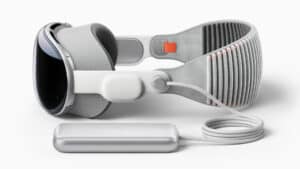Apple Announces the Vision Pro AR/VR Headset
 Apple Makes a Big Announcement
Apple Makes a Big Announcement
On June 5, 2023, Apple announced the long-awaited Vision Pro AR/VR headset.
Apple launches the product into a narrow, skeptical market that has seen similar efforts by Microsoft (HoloLens 2) and Meta (Quest 2) sell well below expectations set for the metaverse revolution. Yet Apple brings to the table a long list of successful market making products that it only launched when it knew it had the technology and the ensuing experience correct. Apple also can capitalize on internal chip development efforts including the M2 processor and its new companion sensor chip, the R1. It brings forth a dedicated OS platform, Vision OS, that builds upon the ease-of-use paradigms that are respected by end users.
The Vision Pro
Apple has entered crowded markets before and set itself above the others. Its watch is the gold standard, and it’s Apple TV products are far easier to use than similar streaming boxes. And of course, the iPhone changed the cell phone market in 2007. We excuse the HomePod.
In the Vision Pro, Apple has combined industrial design, powerful yet power-economized technology, ease of use controls, AI enabled gesture and speech capabilities and an augmented reality implementation that joins the external and the virtual reality worlds without forcing the user to choose one or the other. We had always said that Microsoft HoloLens had the best headset implementation because it overlaid the digital world on the existing world rather than forcing an artificial world that most find only useful for gamers. But the VisionPro leaves the HoloLens far behind.
Apple’s Spatial Computing World
In watching the announcement, Apple has brought us what it calls the spatial computing world, a far better representation of how these products can be used than what Meta did with the Metaverse. Meta seems to focus on a world that is artificially created. Apple concentrated on not blocking the user’s eyes from others in the room and the user constantly is made aware of what is around them rather than being blind to their surroundings in the VR world.
While Apple does use a clever avatar (persona) it creates for the user to use in collaboration activities (because the headgear cannot look back on itself due to the user’s visage being blocked by the headset), it does not rely on this for the full experience. To create the persona the user during setup points the glasses at their face much like users do for image recognition on their phones.
The apps must be seen to really understand the breakthroughs in the software design. Those can be viewed at apple.com. Developers will add a large portfolio of apps in the coming months because it is a new product category that many have been waiting for and expect it to be done well. Also expect vertical markets to jump on the product to both get the experience of using this and to address the many enterprise use cases for the Vision Pro (e.g., warehouses, utilities, etc. …See Microsoft HoloLens markets as well as Zebra Technologies markets).
The Downsides to Adoption
There are some downsides to adoption. We noticed a cord hanging down from the unit and never saw a battery in the exploded electronics diagram. Mobile applications will likely need future belt mounted power packs. Apple has tried to make the unit lightweight and comfortable but wearable fatigue has to be tested by the market. For those who wear glasses Apple said there will be lens inserts to ensure that vision is not compromised. This will add to the cost per user.
Apple in focusing on Artificial Reality (AR) instead of Virtual Reality (VR) has likely dealt with the troubles of VR headsets that include motion sickness, eye strain, headaches and social isolation. But we will see how long users state they can wear the Vision Pro and remain productive.
The Cost
So, is $3499 for a Vision Pro a barrier to entry? We don’t think so. Developers en masse will want to try the product. And as mentioned above there are many mobile vertical markets where a digital overlay over the actual world can act as a real time instruction guide in completing mission critical tasks. Apple projects over 900,000 devices to be sold in a single calendar year. We think they will be constrained. Expect prices to gradually reduce but Apple has never sold on cost and we think that these products will likely stabilize at just below $2000 in the next 2 years.
Bottom Line:
Vision Pro is one of the breakthrough products of 2023 and beyond. It takes a troubled market for AR/VR products and gives it a path forward. Given the many applications that we can see for the product, its worth at least one unit to keep abreast of the technology.
For More Insights on the Emerging Technology To Know- Catch Our Upcoming Webinar!
Aragon Research’s 2023 Technology Arcs

Aragon Research’s 2023 Technology Arc
Aragon’s CEO and Lead Analyst, Jim Lundy introduces Aragon Research’s 2023 Technology Arc.
This webinar focuses on emerging technologies that organizations should consider when developing, deploying, and evolving the digital workplace, digital business, and digital operations. It includes technologies, technology-enabled business disciplines, and technology-driven trends.
Jim will answer:
- How does Aragon Research determine the technologies to highlight in this Tech Arc?
- What are the major trends emerging from this 2023 Tech Arc?
- How do organizations use this Tech Arc to make investment decisions?


Have a Comment on this?